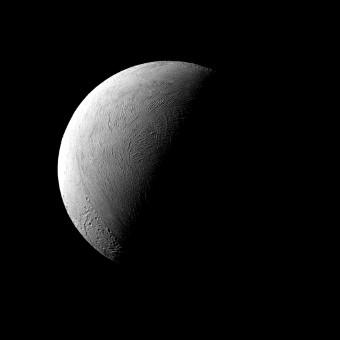
Image courtesy of NASA
Half Moon, Or Half Enceladus?
| published January 25, 2016 |
By Thursday Review staff
If you answered “half Enceladus,” you would be correct, Jeopardy fans. If your next question was “what’s an Enceladus,” don’t fret about your lack of space knowledge.
Enceladus is a satellite of the massive planet Saturn, its sixth largest moon in mass and about one tenth the size of Saturn’s biggest moon, Titan. Though in this NASA photo it bears it striking resemblance to Earth’s moon, the similarities are strictly superficial, as our moon is composed of rocky surface features and volcanic regions which date back many millions of years. Enceladus’ terrain is festooned with much younger features—drifting lines, fluid patterns, troughs and scarps, and soft, dune-like wrinkles and berms—which reveal that its surface is a work-in-progress. Adding to the proof of its youthfulness: a general lack of impact craters, meaning it has not had the same amount of time as other planets and moons to accumulate violent impacts from meteorites, asteroids and other fast-moving objects.
This NASA-JPL photo was taken by the Cassini spacecraft last fall, but was recently released by NASA. Cassini was about 80,000 miles above the surface of Enceladus when the image was captured using the sophisticated camera developed by the Jet Propulsion Laboratory and Caltech scientists in Pasadena, California.
According to NASA, Enceladus—a member of Saturn’s wide and highly dispersed E ring—is 313 miles in diameter. Though this makes it very small—only tiny percentage of the size of Earth’s moon—Enceladus is extremely bright, and is one of the most easily sighted of Saturn’s largest moons. It’s soft, snow-like white surface easily reflects light from the sun. It was discovered in August of 1789 by the famed astronomer and star cataloger William Herschel. A large percentage of its atmosphere is made up of water vapor.
Related Thursday Review articles:
Saturn in Repose; Thursday Review staff; Thursday Review; August 28, 2015.
Saturn’s Outward Calm; Thursday Review staff; Thursday Review; May 18, 2015.
